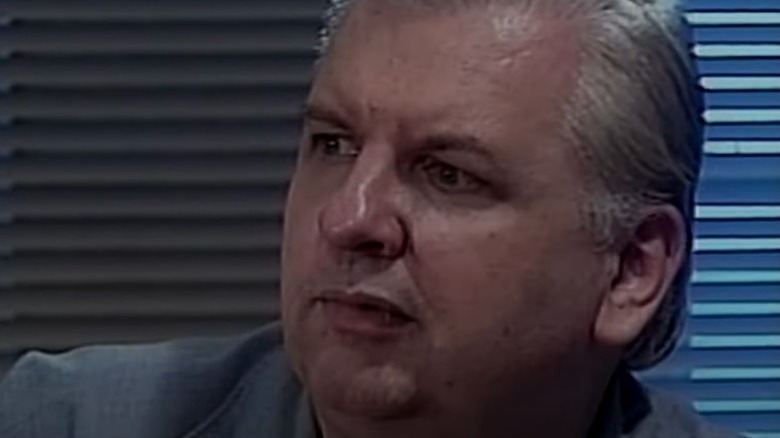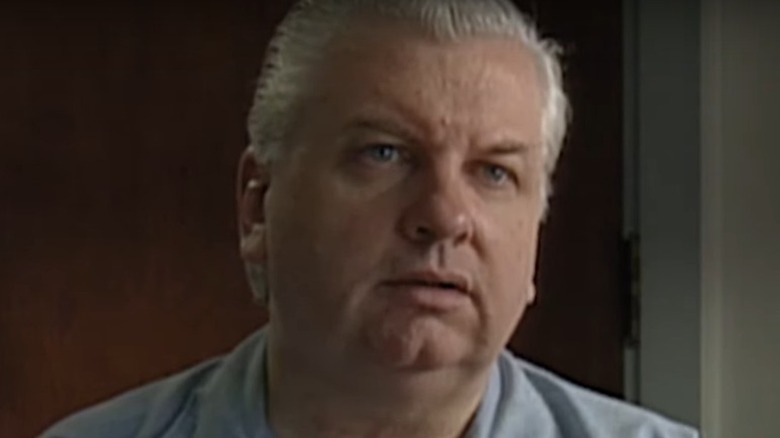Here's Why Some Experts Believe John Wayne Gacy Had An Accomplice
When John Wayne Gacy was arrested in December 1978, police examined the crawlspace of his Chicago house, where the bodies of 26 victims lay underneath thin layers of soil and lime. Additional bodies were found buried in Gacy's yard and the Des Plaines River, bringing his staggering death toll to at least 33 (per Biography).
Gacy was an active killer between 1972 and 1978, the bulk of his murders occurring in the latter two years before his arrest. His practice of cruising for potential victims and eventually drugging, sexually assaulting, and strangling them would take a lot of time and effort, which has made some people wonder if Gacy might have had some help in his crimes. A contractor by trade, Gacy had numerous male employees in and out of his house and garage. One man, David Cram, testified in Gacy's murder trial that he unknowingly dug shallow graves for many of Gacy's victims in 1976 when Gacy paid the man to dig trenches in the crawlspace. Cram believed that he was doing it for the benefit of new plumbing (via The Montreal Gazette). Cram lived with Gacy for a time, as did several of Gacy's other employees.
With all the murderous activity at the Gacy residence, it's no wonder that some speculate that there was either an accomplice or, at the very least, a witness to any of his crimes. These suspicions go beyond the curtain that separates conspiracy theories from reality, as there are professionals who point out numerous pieces of evidence that lend credence to the theory that Gacy had at least one assistant as he committed his crimes.
Experts maintain that there's evidence Gacy didn't work alone
The prosecuting attorney who brought Gacy to trial was Terry Sullivan. Sullivan told WGN News (on YouTube) that he always felt that there were a lot of loose ends involving the Gacy case. The news outlet points out that one Gacy victim who was lucky enough to escape was Jeffrey Rignall. Rignall had been drugged by Gacy after getting into Gacy's vehicle, before being driven to his home. Once there, Rignall was tortured and sexually assaulted before Gacy dropped him back off at the park where the two had met (per the Associated Press). WGN reports that Rignall later told police that someone was with Gacy in the house during the assault.
Chicago attorney Robert Stephenson stated in an interview with WGN that "there is significant evidence out there that suggests that not only did John Wayne Gacy not operate alone, but that he may not have been involved in some of the murders." Stephenson began working with fellow attorney Steve Becker to follow tips and leads that would help family members get needed closure.
They point to one of Gacy's victims, Robert Gilroy, who went missing on September 15, 1977. His body was later recovered along with 25 other bodies that were buried in Gacy's crawlspace. Though Gacy was charged and convicted of Gilroy's murder, there is evidence that showed Gacy flew to Pennsylvania on September 12 and stayed there until the evening after Gilroy disappeared.
Gacy might have had someone recruit victims
Russell Nelson disappeared on October 17, 1977. A supposed friend of Nelson's phoned Nelson's mother to tell her that he and Nelson had gone to a club on the 17th and that Nelson vanished while they were outside later in the evening. The friend said that he'd happily stay in Chicago to continue a search for Nelson, but that he'd need her to send him money to cover expenses. The man would call several more times over that week, demanding money and threatening the woman. This prompted Nelson's brothers to make a trip to Chicago to meet with the man who had been corresponding with their distraught mother. While talking to the man, he offered the brothers a job doing work for Gacy (via WGN News on YouTube).
This prompts Stephenson and Becker to believe that Gacy had at least one accomplice. The cause of death listed for both Gilroy and Nelson differs from Gacy's typical M.O. They point out that Gacy would normally kill his victims by strangling them with a "torture board," fashioned out of a rope and plank. Rather than die from strangulation, Gilroy and Nelson were ruled to have died from strangulation. Their autopsies showed that both men had traces of cotton in their throats, presumably from a wad of cloth being forcibly placed there.
Gacy weighed in on this point during a prison phone call with a friend. He cited autopsies from a total of 13 victims that died in roughly the same fashion as Gilroy and Nelson, pointing out that common sense would tell you that more than one killer was involved.
Gacy's case is similar to another killer's M.O.
During interrogation, Gacy was asked about the torture board and what inspired him to do it. He told the detective that Elmer Wayne Henley, an accomplice of Texas serial killer Dean Corll, put the idea into his head. Corll's case has some patterns similar to Gacy's, however, other than the torture board. Corll killed 28 young men and boys, strangling them to death after subjecting them to torture and sexual assault. Corll was known to use handcuffs in his murders, a trick that Gacy also utilized. Stephenson points out that the similarities in Gacy and Corll's M.O.s are almost identical. He also states that "one of the most significant parts about Corll is that he used two much younger individuals to assist him in gathering up and luring in his victims" (per WGN News, posted on YouTube).
Gacy's defense attorney disputes these claims. He tells WGN that Gacy confessed to all 33 murders to police and that it wasn't until he was behind bars that the condemned killer began to change his tune.
Stephenson and Becker are sure that Gacy is a killer. The two lawyers simply want all the answers laid out so that anyone else who participated in these murders could be brought to justice (via CBS News). Though the evidence they gathered was presented to Chicago law enforcement, there has never been sufficient evidence to charge any of the potential accomplices with any crimes.



